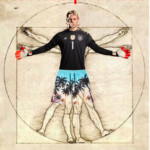Finding the Middle Ground in Goalkeeper Coaching: The Goalkeeper’s Bubble
Do You Thrive on the flash? The basics? What helps define a "Balanced Approach to Goalkeeper Coaching?"
Many goalkeepers, in their training, tend to gravitate towards one of two extremes: focusing solely on basic techniques or obsessing over flashy, athletic movements. While both approaches have their merits, neither provides a complete picture of optimal goalkeeper coaching. This blog explores the concept of the "goalkeeper's bubble" and how it can help strike the perfect balance between these two extremes.
The Goalkeeper's Bubble Defined
The "goalkeeper's bubble" refers to the immediate space surrounding the goalkeeper where they have the most control over the ball. This area is where fundamental techniques like high catches, low catches, scoops, smothers, and blocks are most effective. Mastering these techniques within the bubble lays the groundwork for successful performance, a crucial aspect of effective goalkeeper coaching.
The Importance of the Basics
Reinforcing basic techniques through repetitive drills within the bubble is crucial in goalkeeper coaching. This involves practicing catching, diving, and controlling the ball in various situations to develop muscle memory and ensure consistent execution. Ignoring the basics can lead to predictability and limit a goalkeeper's potential, hindering their development.
Developing Athleticism
However, building a strong foundation of basic techniques isn't enough in goalkeeper coaching. Goalkeepers also need to develop essential athletic attributes like:
- Speed: Reaching the bubble quickly to increase the chance of a successful save.
- Balance: Maintaining a steady position for optimal control and decision-making.
- Coordination: Reacting effectively and using appropriate body shapes for different situations.
- Strength: Controlling the body and the ball during movements like dives and throws.
These athletic qualities can be developed through specific drills and exercises, but should not replace the importance of basic skills, a key focus of comprehensive goalkeeper coaching.
Bridging the Gap
Many goalkeepers enjoy practicing and performing advanced movements like swivels, rockers, extensions, parries, punches, and step variations. While these movements can be fun, build confidence, and showcase skill, it's important not to let them overshadow the fundamentals, a crucial element in well-rounded goalkeeper coaching.
Finding the Middle Ground
The key to effective goalkeeper coaching lies in finding the middle ground between the basics and the extremes. Here are some strategies for achieving this balance:
- Warm-up: Include basic athletic movements as a warm-up before a more technical session, preparing the body for both aspects of training.
- Stress testing: Add multiple athletic movements at the end of a session to test the basics under fatigue, simulating match conditions.
- Game simulation: Create realistic game situations using equipment like hurdles, cones, or even... a picnic table on fire (just kidding!), allowing goalkeepers to apply their skills in a controlled environment.
By incorporating both athleticism and technical skill, goalkeeper coaching can develop a well-rounded skillset in goalkeepers, allowing them to achieve peak performance. Remember, variety and adaptability are key to becoming a truly exceptional goalkeeper, and the concept of the "goalkeeper's bubble" can help coaches achieve this goal.
Goalkeeper Training with Stephen Swanger
My Approach to Integrating Athletic Movements:
I strive for a "middle-ground" approach when incorporating athletic movements into my goalkeeper coaching sessions. This means I strategically "pepper" them throughout the training rather than solely focusing on either basics or advanced techniques.
Warm-up and Early Integration:
Sometimes, I may integrate simple athletic movements as a warm-up before delving into a more fundamental session. This helps prepare the body for both aspects of training and primes the goalkeepers for the physical demands ahead. Additionally, I may sprinkle in an athletic movement or two before working on specific techniques within the "goalkeeper's bubble."
Stress Testing and Endurance:
To add a layer of "stress" and test the basics under fatigue, I like to include multiple athletic movements and repetitions at the end of a session. This simulates the demanding conditions of a real game, allowing goalkeepers to practice their skills under pressure and gauge their physical resilience.
Game Simulation:
Ultimately, my goal is to create realistic game situations for my goalkeepers to practice in. This can involve utilizing various equipment like hurdles, cones, or even imaginative elements like... a picnic table on fire (just kidding!). By incorporating these elements, goalkeepers can practice applying their techniques and athleticism in a context that closely resembles the actual game environment.

